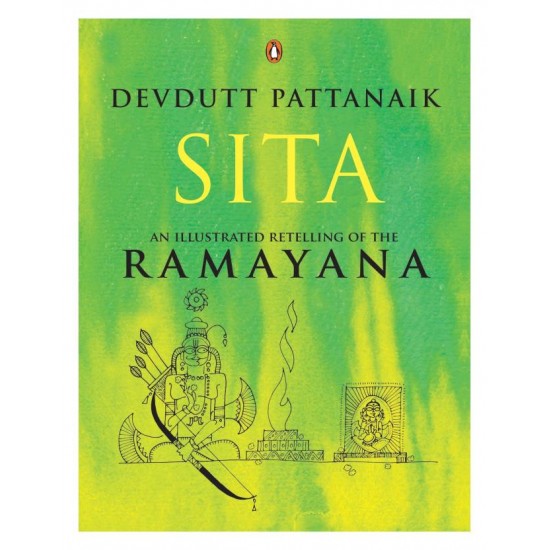
Sita: An Illustrated Retelling Of The Ramayana is the Ramayana retold with the focus of the story being on Sita, Rama’s devoted and loyal wife.
Flipkart Official Review
Retellings of epic myths are almost the in thing. Everyone is writing about them. Everyone has their version to the Mahabharata or the Ramayana. This time round though, the renowned mythologist, Devdutt Pattanaik is back with his story of Sita and the Ramayana.
We have all grown up with a certain idea of the Ramayana and how it should be. Devdutt just makes us look closely to the humane side of it. Rama is still a man who longs for his wife and Sita is still a woman who waits for her husband. The crux of the story is that and yet it is about faith, dharma and being righteous. The illustrations with the writing make the book more intriguing and add a lot of mythical value.
Devdutt takes the reader to a different journey across The Ramayana, which the reader will never forget. A must read this year.
Exclusive article by Devdutt Pattanaik for Flipkart Customers
Even though Sita plays a pivotal role in the Ramayana, when you actually seek her out you realize she is but a prop, appearing and disappearing, with her marriage, her abduction, her rescue and finally her banishment. Who is she really? There are tantalizing clues in classical as well as subaltern literature and in folk traditions, but nothing else.
And then, of course, there is the attempt of modern writers to portray her as a helpless, hapless victim, shaped both by the tragic state of women in many parts of the world and by modern political prejudices against all things religious. So you wonder if you really know Sita at all. And this enquiry made me seek Sita.
The journey to discover Sita makes you realize that the Ramayana is not a book, as most people assume, but a vast tradition manifesting itself in written, oral and visual traditions. And for some reason, children of India have been kept away from it. Yes, we are told of the Valmiki Ramayana, but we are not told that there are several versions of this original story itself a northern version, a southern version, an eastern version, which have barely a third of the verses common between them. Then there are Sanskrit plays written by dramatists like Bhasa and Bhavabhuti where Ram is a great hero, not necessarily God. Then we find Ramayanas of the Jains, the Buddhists as well as from South East Asia, which retell the same story but with a very different emotion. From the tenth century onwards we find the Ramayana in each and every Indian language, written by several authors, in different scripts, with different styles, all deeply immersed in bhakti. It is through these regional narratives, not the Sanskrit ones really, that ideas related to love, valour, fidelity and wisdom spread to every corner of India.
Besides songs and stories, there are also the visual narrations in the form of carvings and murals on temple walls, paintings on cloth and paper such as the Mewari and Rajasthani miniatures and Kalamkari and Patta-chitra and Chitrakathi artworks. In some of these we find Ram with a moustache, in others with a six-pack. All these amused and inspired me and I wanted to share them with the world.
And in this storm of ideas stands steadfast the quiet Sita, very different from the fiery and vengeful Draupadi. Her silence has been taken to mean submission by those who forget she is the daughter of Janaka who was the patron of the Upanishads, the body of work that captures the essence of Vedic thought. Through her silence she conveyed her serenity and sagacity, unflustered by the restraints of culture, demands of morality and the rage of villains.
We today are too busy wanting to be heard. We do not bother with listening. This book is written so that we listen to Sita and through her discover a uniquely Indian approach to justice, fairness and most importantly, love.
Summary Of The Book
Ramayana is the story of Rama, the son of King Dasharatha. He was the heir to his kingdom, an empire. Yet, due to the malice prevalent in the palace, the Prince was exiled. He had to live in the forest with his wife and his younger brother for fourteen years. Rama took this step to ensure that his father’s reputation as a man who keeps his word, was not tarnished.
One of the underlying themes of the Ramayana echoes the upholding of tradition, reputation, and the family image. The Ramayana is all about obeying the rules and laws of Dharma, and about maintaining reputation even if it means personal loss and unhappiness. According to this book, this is the key to understanding the story of Sita in the Ramayana.
Who is Sita? She plays a prominent role in the epic, but is a very quiet and restrained character. Her husband adores her, yet he abandons her in the end because of the persistent gossip among his subjects about Sita’s fidelity. Through all her travails, Sita remains quiet, does not lose her composure, and does not vocally demand retribution, like the fiery Draupadi of the Mahabharata. Draupadi is acknowledged as a strong character, and she is. But, Sita is often viewed as meek and submissive.
Sita’s silence is not the silence of the weak. It is the silence of the ascetic, who knows the truth, and so is patient. She knows her husband loves her, and she is indispensable to him. Moreover, she knows she is the Goddess who makes him the God, the woman who makes him the whole man.
She was found as a baby in a furrow when Janaka ploughed a tract of land to prepare for a yagna. Thus, from the beginning, she is special and stands apart. Even when she is held captive by Ravana, she does not really fear him.
Sita: An Illustrated Retelling Of The Ramayana explores the enigma of Sita and explains her real strength of character. It is a very interesting analysis of a woman most people might think was a weak character, who was supposed to represent the ideal of submissive womanhood. This book shows why this was not so.
About Devdutt Pattanaik
Devdutt Pattanaik is a doctor who became a writer.
Other books by this author include Business Sutra: A Very Indian Approach to Management, 7 Secrets of Vishnu, Jaya: An Illustrated Retelling of the Mahabharata, The Book of Ram, and Hanuman's Ramayan.
Devdutt Pattanaik is a doctor who worked in the pharmaceutical and healthcare industry for many years. Throughout his life, he has also been deeply interested in Hindu mythology, the epics, puranas and the many legends and divine tales. So, after almost fifteen years in the healthcare industry, he switched his career. He began to focus on writing about Hindu mythology and using the Hindu scriptures to teach lessons in business management. He is now the Chief Belief Officer at the Future Group.
Interview with Devdutt Pattanaik
1. The Ramayana has had a whole lot of characters. Why did you settle on Sita to tell your story?
Though Sita plays a pivotal role in the Ramayan, she is actually in the background, merely a device to talk about Ram. It came as a surprise to me. Further, I read many new retellings and reimaging of Sita on feminist lines, and many of these were part of the ‘victim’ discourse which I felt was a unflattering portrayal of Sita; my reading of mythology had revealed a very different woman. Wanted to share it with the world.
2. Sita has always been rather off-late, spoken about in quite a feminist manner. What are your thoughts or views on it?
Somehow these feminist retellings make her sound like a victim. A Goddess cannot be a victim. Shit happens in life. We have a choice whether to be victim or hero or avenging angel, or sage. I did not find much about Sita, the sage. A huge gap that needed to be filled.
3. Devdutt's take on Mythology
Stories, symbols and rituals that communicate the subjective truth or beliefs of a people.
4. What are you reading as of now?
First draft of my next book but I won’t tell you about it.
5. How did you spin this story? Where did the idea come from?
I always wondered what it would be like to be daughter of the legendary Janaka, patron of the Upanishads. Few talk about it. I also wondered what Sita did in those days of her captivity. Folklore has a few clues, and these excited me as no one I knew had heard these details. Also in pilgrim spots across India, the suggestion of Ram’s celibacy during exile made me wonder what if felt like for a young couple to be denied marital rights. Then the many retellings of the tale, usually commented upon by Western scholars who are not the most sensitive lot in the world owing to demands of modern academia. People usually focus on the radical; I loved the finer nuances in the tale, the different approaches to Ahilya or Surpanakha or Hanuman or Tara. So much knowledge hidden from India’s youth. All these churned in my mind and finally turned into this retelling.
6. Do you think Sita's voice gets lost in the Ramayana? Is there anything as more focus on Ram than Sita?
It is Ramayana – story of Ram so every other voice is secondary. But your questions suggests that she is deliberately silenced. Many authors read the epic in this way and deliberately make it sound like something it never was. Sita’s voice is the human voice. We are not always heard because we are busy hearing.
7. Sita's side of the story. We hear that a lot these days. Is there a side to Ramayana at all? According to you, should there be different perspectives to mythology?
This side-business is a modern curse. We have Right side, Left side, male side, female side, victim side, oppressed side etc…..we miss the point of the epic by making it political to satisfy our own agendas and making the book what it is not. We see Ram as male and Sita as female because the Western template on which our education system is based on is unable to appreciate the symbolic. We are too eager and impatient to see things at a superficial level and declare ourselves liberal.
8. Your favourite work on Sita (if any)
Sita, an illustrated retelling of the Ramayana, published by Penguin India and sold at Flipkart.
9. Devdutt's favourite mythological books
Myth=Mithya, published by Penguin India and sold at Flipkart. (Feel free to judge me as a narcissist, but I refuse to submit to the modesty template)
| Books Information | |
| Author Name | Pattanaik Devdutt |
| Condition of Book | Used |
- Stock: In Stock
- Model: sg14038






















